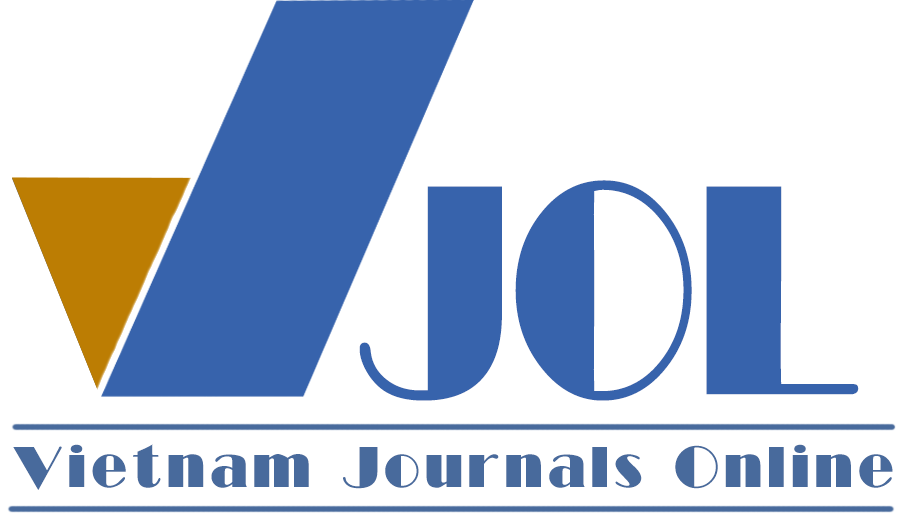Building personal branding: The impact of self-expression, social interaction, and personal value
Authors
DOI: https://doi.org/10.57110/vnujeb.v3i4.195Keywords:
Personal branding, self-expression, social interaction, personal value, Vietnamese youthReferences
Amoako, G. K., & Okpattah, B. K. (2018). Unleashing salesforce performance: The impacts of personal branding and technology in an emerging market. Technology in Society, 54, 20-26. https://10.1016/j.techsoc.2018.01.013
Boote, A. S. (1981). Reliability testing of psychographic scales: Five-point or seven-point? Anchored or labeled? Journal of Advertising Research, 21, 53-60.
Bui, H. Q., & Tran, T. T. (2023). CMC users' positive and negative emotions: Features of social media platforms and users' strategies. Multidisciplinary Applications of Computer-Mediated Communication (pp. 188-210). IGI Global.
Clark, L. & Watson, D. (1995). Constructing validity: Basic issues in objective scale development. Psychological Assessment, 7, 309-319. https://doi.org/10.1037/1040-3590.7.3.309
Comrey, A. L., & Lee, H. B. (1992). Interpretation and application of factor analytic results. In A first course in factor analysis (2nd ed.). Lawrence Erlbaum Associates.
Dawis, R. V. (1987). Scale construction. Journal of Counseling Psychology, 34(4), 481-489. https://doi.org/10.1037/0022-0167. 34.4.481
Dewan, S. (2020). The role of personal image in personal branding. Cuadernos Del Centro De Estudios En Diseño Y Comunicación, (118). https://doi.org/10.18682/cdc.vi118.4146
Fanning, E. (2005). Formatting a paper-based survey questionnaire: Best practices. Practical Assessment, Research, and Evaluation, 10(1), 12. https://doi.org/10.7275/s84t-8a63
Frendika, R., Sule, E. T., & Kusman, M. (2018). The power of personal values and cultural competence towards personal branding of employees. Academy of Strategic Management Journal, 17(1), 1-10.
Gandini, A. (2015). Digital work. Marketing Theory, 16(1), 123-141. https://doi.org/10.1177/1470593115607942.
Gorbatov, S., Khapova, S. N., & Lysova, E. I. (2018). Personal branding: Interdisciplinary Systematic Review and research agenda. Frontiers in Psychology, 9, 2238. https://doi.org/10.3389/fpsyg.2018.02238
Gorbatov, S., Khapova, S. N., & Lysova, E. I. (2019). Get noticed to get ahead: The impact of personal branding on career success. Frontiers in Psychology, 10, 2662. https://doi.org/10.3389/fpsyg.2019.02662
Hair, J. F., Hult, G. T. M., Ringle, C. M., & Sarstedt, M. (2014). A primer on partial least squares structural equation modeling (PLS-SEM). SAGE.
Hair, J. F., Ringle, C. M., & Sarstedt, M. (2011). PLS-SEM: Indeed a silver bullet. The Journal of Marketing Theory and Practice, 19(2), 139–152. https://doi.org/10.2753/mtp1069-6679190202
Han, L. H. B. (2020). Vietnamese generation Z’s attitude towards YouTube influencer marketing. Theseus.fi. https://www.theseus.fi/handle/10024/572442
Haroen, D. (2014). Personal branding. Gramedia Pustaka Utama.
Henseler, J., Ringle, C.M., & Sarstedt, M. (2015). A new criterion for assessing discriminant validity in variance-based structural equation modeling. Journal of the Academy of Marketing Science, 43(1), 115–135. https://doi.org/10.1007/s11747-014-0403-8.
Hinkin, T. R. (1998). A brief tutorial on the development of measures for use in survey questionnaires. Organizational Research Methods, 1(1), 104-121. https://doi.org/10.1177/109442819800100106
Ho, T. T. H., Le, V. H., Nguyen, D. T., Nguyen, C. T. P., & Nguyen, H. T. T. (2022). Effects of career development learning on students’ perceived employability: A longitudinal study. Higher Education, 86, 297-315. https://doi.org/10.1007/s10734-022-00933-6
Holton, A. E., & Molyneux, L. (2017). Identity lost? The personal impact of brand journalism. Journalism, 18(2), 195-210. https://doi.org/10.1177/1464884915608816
Hood, K. M., Marcel, R., & Hopkins, C. D. (2014). Personal branding and social media for students in today’s competitive job market. The Journal of Research in Business Education, 56(2), 33-47.
Jin, S.-A.A., Muqaddam, A., & Ryu, E. (2019). Instafamous and social media influencer marketing. Marketing Intelligence & Planning, 37(5), 567-579. https://doi.org/10.1108/mip-09-2018-0375
Khedher, M. (2019). Conceptualizing and researching personal branding effects on the employability. Journal of Brand Management, 26(2), 99-109. https://doi.org/10.1057/s41262-018-0117-1
Kline, R. B., & Little, T. D. (2015). Principles and practice of structural equation modeling (4th ed.). Guilford Publications.
Kucharska, W., & Mikołajczak, P. (2018). Personal branding of artists and art-designers: necessity or desire? Journal of Product & Brand Management, 27(3), 249–261. https://doi.org/10.1108/jpbm-01-2017-1391
Kucharska, W., & Mikołajczak, P. (2018). Personal branding of artists and art-designers: Necessity or desire? Journal of Product & Brand Management, 27(3), 249-261. https://doi.org/10.1108/jpbm-01-2017-1391.
Mai, N. T. T., & Linh, N. H. (2017). Antecedents of the intention and behavior toward purchase of counterfeit luxury goods in an emerging economy: A study of young Vietnamese consumers. Organizations and Markets in Emerging Economies, 8(2), 207-224.
Marin, G. D., & Nilă, C. (2021). Branding in social media. Using LinkedIn in personal brand communication: A study on communications/marketing and recruitment/human resources specialists perception. Social Sciences & Humanities Open, 4(1), 100174. https://doi.org/10.1016/j.ssaho.2021.100174
McCool, L. B. (2019). Next-gen résumés: A case study of using transmedia storytelling to create personal branding on LinkedIn. Technical Communication, 66(3), 230-243.
Nghi, N. Q., Huyen, K. N., Cuong, P. Q., & Thanh, L. K. (2017). The factors affecting satisfaction on conducting scientific research among young lecturers in Can Tho University. Can Tho University Journal of Science, 51, 41-52.
Nguyen, T. N., McDonald, M., Nguyen, T. H. T., & McCauley, B. (2020). Gender relations and social media: A grounded theory inquiry of young Vietnamese women’s self-presentations on Facebook. Gender, Technology and Development, 24(2), 174-193. https://doi.org/10.1080/09718524.2020.1719598
Orehek, E., & Human, L. J. (2017). Self-expression on social media. Personality and Social Psychology Bulletin, 43(1), 60-70. https://doi.org/10.1177/0146167216675332
Park, J., Williams, A., & Son, S. (2020). Social media as a personal branding tool: A qualitative study of student-athletes’ perceptions and behaviors. J. Athl. Dev. Exp, 2(1), 2.
Philbrick, J. L., & Cleveland, A. D. (2015). Personal branding: Building your pathway to professional success. Medical Reference Services Quarterly, 34(2), 181-189. https://doi.org/10.1080/02763869.2015.1019324
Plume, C. J., & Slade, E. L. (2018). Sharing of sponsored advertisements on social media: A uses and gratifications perspective. Information Systems Frontiers, 20, 471-483. https://doi.org/10.1007/s10796-017-9821-8
Shepherd, D. H. (2005). From Cattle and Coke to Charlie: Meeting the challenge of self-marketing and personal branding. Journal of Marketing Management, 21(5-6), 589-606. https://10.1362/0267257054307381
Tran, T. T. (2013). Limitation on the development of skills in higher education in Vietnam. Higher Education, 65(5), 631-644. https://doi.org/10.1007/s10734-012-9567-7
Trang, N. M., McKenna, B., Cai, W., & Morrison, A. M. (2023). I do not want to be perfect: Investigating generation Z students’ personal brands on social media for job seeking. Information Technology & People. https://doi.org/10.1108/ITP-08-2022-0602
Valdés, R. M. A., Soriano, A.S., & Álvarez, C. L. (2018). Resignification of educational e-innovation to enhance opportunities for graduate employability in the context of New University Degrees. Journal of New Approaches in Educational Research, 7(1), 70-78. https://doi.org/10.7821/naer.2018.1.263
Vallas, S. P., & Christin, A. (2018). Work and identity in an era of precarious employment: How workers respond to “personal branding” discourse. Work. Occup. 45, 3-37. https://doi.org/10.1177/0730888417735662
Vasconcelos, L., & Rua, O. L. (2021). Personal branding on social media: The role of influencers. E- Revista De Estudos Interculturais, (9). https://doi.org/10.34630/erei.v3i9.4232
Vițelar, A. (2019). Like me: Generation Z and the use of social media for personal branding. Management Dynamics in the Knowledge Economy, 7(2), 257-268. https://doi.org/10.25019/MDKE/7.2.07
Whitmer, J. M. (2021). Between a regular person and a brand: Managing the contradictions of the authentic self-brand. Sociological Quarterly, 62(1), 143-160. https://doi.org/10.1080/00380253.2020.1724058
Downloads
Downloads
Published
Abstract View
PDF Downloaded
How to Cite
Issue
Section
License
Copyright (c) 2023 Nguyen Thi Ha My, Tran Lam Son, Nguyen Thi Thuy Duong, Vu Huong Giang, Nguyen Thi Khanh Chi

This work is licensed under a Creative Commons Attribution-NonCommercial 4.0 International License.
by VNU Journal of Economics and Business
Most read articles by the same author(s)
- Nguyen Thi Khanh Chi, Vu Hoang Nam, The impact of drone delivery innovation on customer intention: An empirical study in Vietnam , VNU University of Economics and Business: Vol. 3 No. 2






